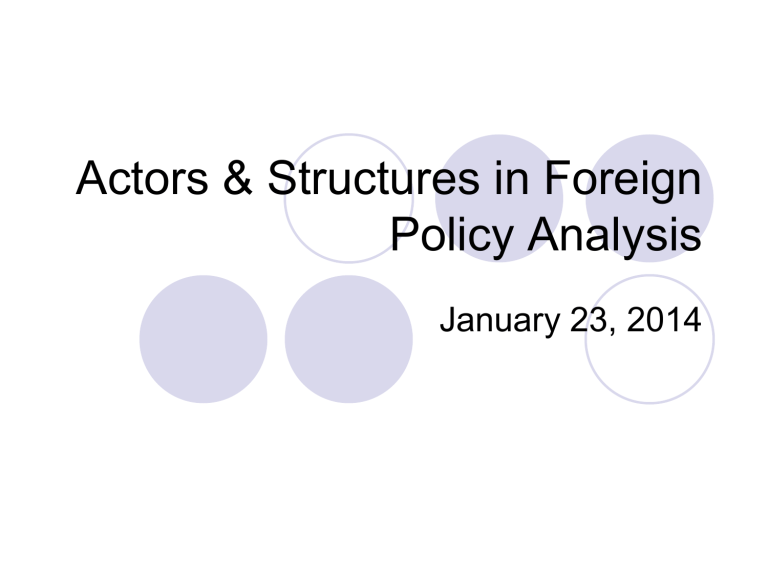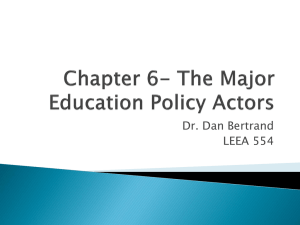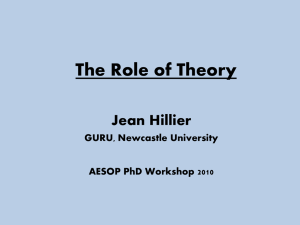January 23

Actors & Structures in Foreign
Policy Analysis
January 23, 2014
Overview
Introduction
Historical background
The role of actors and structures in ‘ process ’ approaches to foreign policy analysis
The role of actors and structures in ‘ policy ’ approaches to foreign policy analysis
A possible solution – integrative framework
Introduction
Foreign policy is impacted by a number of actors and structures, both domestic and international
These actors and structures act in combination all of which makes foreign policy analysis challenging
Scholars have tried to create some kind of analytical framework or approach to make things clearer, but fundamental disagreements remain.
In other words…
Analyzing foreign policy is complicated…
Historical background
Realism: ( Morgenthau)
Effort to provide universal law-like explanations for the external behaviour of all states
Did this by linking the concept of power to national interest.
Idea that with these “laws” in place you explain and understand the behaviour of states
Realism was the dominate approach to IR in the
US during the Cold War
Behaviouralism:
Gained dominance in US social sciences in post WWII era at same time realism was dominating IR in US
Effort to apply scientific approach to social sciences
Idea that could use testable hypotheses to develop a empirical generalisations of political behaviour
Two key questions
What are we trying to explain with our analysis?
i.e. What is the object of our analysis (the explanadum or independent variable)?
What factors do we see as responsible for explaining the thing we are trying to explain?
i.e. What are approaches and instruments that do the explaining (the explanans or dependent variable)
Essentially approaches to foreign policy analysis can be divided based on whether they focus on the decision-making process or on the policy itself when looking for explanatory factors
The role of actors and structures is considered in both approaches, with different perspectives placing more emphasis on one or the other
The role of actors and structures in
‘process’ approaches to FPA
Here the focus is on decision-making; identifying what foreign policy-makers are doing.
Process-orientated analysts of foreign policy consider how certain goals arise and why certain behaviours result.
The role of the decision-making process
Focus on the factors and processes through which foreign policy decisions, statements and behaviours are made
The aim is to explore the process of foreign policy decision-making rather than policies themselves.
Don’t see states as unitary actors
Instead states are the institutional structures within which individual decisionmakers act.
So can’t see actors as generic, because individuals will act differently, so focus on specific individuals
Levels of analysis
Process focused approaches tend to favour a level of analysis framework
At its most basic there are three levels:
Individual
State
International
Impact of actors and structures are examined one level at a time
The role of actors and structures in
‘policy’ approaches to FPA
The focus here is the choice of specific policies, rather than specific decisionmaking process.
Policies are understood to result from processes, rather than being part of them.
The role of actors and structures in
‘policy’ approaches to FPA
The main focus is the action that is the product of the decision (i.e. the policy); distinguishing a foreign policy action from the process that preceded it.
The focus is on policy agreements, not the behaviour of any particular entity.
These approaches vary in the degree to which they see either actors or structures as more important
Structural perspectives and foreign policy
Realism (aggressive and defensive neorealists, neoclassical realists)
Neoliberal institutionalism (regime theory)
Constructivism
These perspectives don’t exclude actors in their analysis, but instead see the structure as the key factor explaining how states behave
Actor-based perspectives and foreign policy
Cognitive and psychological approaches
Bureaucratic politics approach (Allison)
New liberalism
Interpretative actor perspective
Cognitive & psychological approaches
Contrasts with realist and liberal approaches that see actors as rational
i.e. actors are open-minded and adapt to changing circumstances
Instead cognitive and psychological approaches suggests that a variety factors can get in the way, including:
Individual beliefs, personality, the way they process information & cognitive traits
An example: Groupthink
Coined by Irving Janis in the 1970s
Idea that highly cohesive groups under significant pressure to make a good decision and maintain unanimity can end up acting irrationally and fail consider alternative approaches
Janis’ examples: Bay of Pigs, failed Iran hostage rescue, US failure to anticipate
Pearl Harbour
Bureaucratic politics approach
Idea that internal negotiating and infighting results in a final decision that no person or group in the decision-making process intended
Thus, focus of this approach is on interactions of individuals or groups inside the organisation
New liberalism
In contrast to neoliberalism, focus on the importance of actors rather than institutions
In particular looks at importance of societal actors rather than politically appointed actors or groups
Interpretive actor perspective
Emphasizes the role of individual decisionmakers as key explanatory factor
Thus, focus on analyzing the thinking and actions of particular individuals
Agency-structure problem
Tendency to see either actors or structures as key to explaining particular policy choice
Thus, treat them as distinct from one another
Problem is that in real world actors and structure interact and influence one another, so can’t really look at them separately
Challenge is to find an approach that integrates impact of both actors and structure across all levels of analysis
Potential solution - integrative framework
Foreign policy actions are explained in a threeway structure of intentional, dispositional and structural dimensions.
Integrative framework
Step 1
Focus first on the relationship between a given foreign policy action and the intention or goal that was behind it
Essentially trace reasoning behind a specific action - i.e. they did this in order to achieve that
Example: the US decision to invade
Iraq
Starting from step 1, what kind of things would we look for to examine the intentional dimensions of the decision to invade Iraq?
How would we determine what the specific goal(s) or intention of the invasion was?
Integrative framework
Step 2
Trace the link between the intentional and the dispositional dimensions, focusing on the underlying values that motivate actors to pursue certain goals over others.
Here bring cognitive & psychological approaches
Perceptions, beliefs, values etc.
These first two steps focus on actors
US and Iraq
Based on step 2 how would we analyze why the US decision-makers chose those particular goals over others?
What kinds of information would we be looking for to help us explain these choices?
Integrative framework
Step 3
Examines how structural factors affect actors
Looks at how these structural factors are perceived, reacted to and taken into account by the actors.
Structural factors affect the cognitive and psychological dispositions of individuals.
Can either enable or constrain actors’ dispositions
US & Iraq
How would we determine how structural factors and the actors perceptions of them impact their choices?
What structural factors were likely to be important in this case?
Integrative framework
Not a complete solution to agencystructure problem
Tends to be a static approach, i.e. can use it to explain a single foreign policy action, but not a series of actions over time






